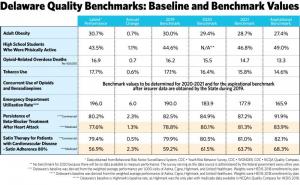Executive order aims to curb healthcare spending
A nine-member subcommittee will set benchmarks for healthcare spending in Delaware following an executive order signed by the governor Nov. 20 designed to rein in rising healthcare costs.
“Delaware has consistently ranked among the highest-spending states for healthcare, but we have not traditionally been a leader in healthcare outcomes. That needs to change,” said Gov. John Carney.
Recent studies have ranked Delaware third in the country in per capita spending, yet it is ranked 30th in healthcare quality.
Last summer, officials began looking into ways to curb healthcare costs, which have increased 4-5 percent a year over the past decade and now consume nearly a third of Delaware's budget.
Under the executive order, healthcare growth in 2019 will be determined in December using a formula that takes into account personal income growth, state population and inflation. By 2020, the spending benchmark would be held to 3.5 percent, dropping to 3.25 percent in 2021 and then 3 percent in 2022 and 2023, according to the order.
“This Executive Order reaffirms our commitment to lowering costs for Delaware families and improving the quality of care that Delawareans receive. We’ll do that, first and foremost, by improving transparency around the cost of healthcare services,” Carney said.
Transparency in healthcare spending was among recommendations submitted in August by Department of Health and Social Services Secretary Kara Odom Walker.
“As a state, we must address the cost of healthcare and the outcomes we are getting for that spending,” she said.
Walker will publish a manual by Jan. 31, 2019, outlining steps public and private healthcare entities will take to show where healthcare costs are increasing. “The Health Care Commission likely will be the public body where most of that information flows through,” said Jill Fredel, director of communications for DHSS.
Following Walker's recommendations, officials said a review of costs is needed in order to understand why a prescription or a month in a nursing home costs so much.
“All of those get lumped into healthcare spending in Delaware, and then we start to understand why it costs so much,” Fredel said in a previous interview. “Let's peel apart what goes into those hospital costs.”
In order to help control healthcare spending, eight categories for healthcare improvement are targeted under the order. For 2019 to 2021, the order sets benchmarks in order to reduce emergency department rates, overdose deaths, overlapping prescriptions, and the number of adults who are obese and those who smoke, while increasing the number of physically active kids, and statin therapy and beta-blocker treatment for heart patients.
The benchmarks coupled with a reduction in spending are meant to keep Delaware's $9.5 billion in healthcare spending from doubling to $21.5 billion in 2025, while improving the poor ranking Delaware residents have received for overall health, officials say.
“What gets measured gets done. We are on a path to ensure that we’re focused on reduced healthcare costs and pairing that with improved health outcomes,” said Walker, a board-certified family physician. “We need better value for every healthcare dollar to allow greater investment in the social determinants of health.”
Subcommitte sets bench
A subcommittee – the Delaware Economic and Financial Advisory Council Health Care Spending Benchmark Subcommittee – the order established will set the spending benchmarks after 2023 and advise DEFAC on spending changes based on healthcare trends. A chair and vice chair who are DEFAC members and have healthcare expertise will head the nine-member committee. Three more DEFAC members will be appointed by the DEFAC chair; two members representing health economists and two quality-improvement experts from a state healthcare system or hospital will all be appointed by the governor.
Secretary of Finance Rick Geisenberger said the subcommittee will help DEFAC in preparing state revenue and expenditure estimates.
“This executive order creates a DEFAC Health Care Spending Benchmark Subcommittee that will solicit public and stakeholder input toward recommending a credible and trusted annual target for per capita growth of total healthcare costs in Delaware,” he said.
Melissa Steele is a staff writer covering the state Legislature, government and police. Her newspaper career spans more than 30 years and includes working for the Delaware State News, Burlington County Times, The News Journal, Dover Post and Milford Beacon before coming to the Cape Gazette in 2012. Her work has received numerous awards, most notably a Pulitzer Prize-adjudicated investigative piece, and a runner-up for the MDDC James S. Keat Freedom of Information Award.
























































